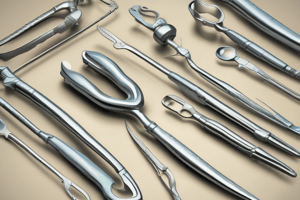Podcast
Questions and Answers
What is the main purpose of hand instruments in dentistry?
What is the main purpose of hand instruments in dentistry?
- To remove calculus, plaque, and stain from tooth surfaces
- To cool the tooth surface during dental procedures
- To explore canals and remove debris during endodontic procedures
- To screen teeth and tissues for defects and abnormalities (correct)
How do ultrasonic instruments differ from hand instruments in dentistry?
How do ultrasonic instruments differ from hand instruments in dentistry?
- Ultrasonic instruments are smaller in size than hand instruments.
- Ultrasonic instruments are more flexible than hand instruments.
- Ultrasonic instruments vibrate at high frequencies compared to hand instruments. (correct)
- Ultrasonic instruments use water as a cooling agent while hand instruments do not.
Which dental instrument is specifically designed for endodontic procedures?
Which dental instrument is specifically designed for endodontic procedures?
- Cures (correct)
- Ultrasonic instruments
- Explorers
- Scalers
How do ultrasonic instruments prevent overheating during dental procedures?
How do ultrasonic instruments prevent overheating during dental procedures?
What is a key characteristic of ultrasonic scalers?
What is a key characteristic of ultrasonic scalers?
Which of the following is true about Cavitrons?
Which of the following is true about Cavitrons?
What is the purpose of Endodontic files?
What is the purpose of Endodontic files?
How do Endodontic motors improve endodontic procedures?
How do Endodontic motors improve endodontic procedures?
Which statement is true about lasers in dentistry?
Which statement is true about lasers in dentistry?
What is a primary goal of using endodontic irrigation systems?
What is a primary goal of using endodontic irrigation systems?
Flashcards are hidden until you start studying
Study Notes
Instrumentation in Dentistry: Unleashing Precision
Dentistry, a field that combines artistry with science, relies on a diverse array of instruments to diagnose, treat, and prevent oral health issues. In this article, we'll delve into three fundamental categories of dental instruments: hand instruments, ultrasonic instruments, and endodontic instruments.
Hand Instruments
Hand instruments, also known as manual instruments, are integral to the everyday dental practice. These tools are available in various shapes, sizes, and materials to accommodate various procedures and accommodate individual dentists' preferences. Common hand instruments include:
- Explorers: Used for screening teeth and tissues, explorers come in different shapes and tip configurations to detect subtle defects and abnormalities.
- Scalers: These instruments are used for removing calculus, plaque, and stain from the tooth surface, both above and below the gum line.
- Cures: Cures, specifically used for endodontic procedures, are thin, flexible instruments used to explore canals and remove debris.
Ultrasonic Instruments
Ultrasonic instruments, also known as sonic or piezoelectric instruments, are high-frequency, vibrating tools that employ ultrasonic energy to remove calculus, plaque, and stains from tooth surfaces. They're more efficient than hand instruments and make use of water as a cooling agent and to prevent overheating. Common ultrasonic instruments include:
- Scalers: Ultrasonic scalers are the most commonly used instruments, known for their speed in removing soft deposits and debris.
- Cavitrons: Cavitrons are a specific type of ultrasonic scaler designed to clean tooth surfaces and remove calculus.
- Lasers: While not typically referred to as ultrasonic instruments, lasers are considered a form of ultrasonic energy that can be used to remove dental tissue and hard deposits from teeth.
Endodontic Instruments
Endodontic instruments are used to prepare and shape the root canals of teeth prior to filling. The goal is to clean and disinfect the root canal system, ensuring that all debris is removed to prevent future infection. Common endodontic instruments include:
- Endodontic files: Ranging in size and taper, endodontic files are used to clean and shape the root canals.
- Endodontic motors: Motorized systems are used to automate the manipulation of endodontic files, improving speed and precision.
- Endodontic irrigation systems: These systems are used to clean and disinfect the root canals during endodontic procedures.
Conclusion
Dental instruments have evolved over time to provide better patient care and improve the overall efficiency of dental practices. The use of hand, ultrasonic, and endodontic instruments has revolutionized dentistry and enhanced the quality of care provided to patients. As technology continues to advance, we can expect to see even more sophisticated instruments and techniques in the field of dentistry.
Studying That Suits You
Use AI to generate personalized quizzes and flashcards to suit your learning preferences.




